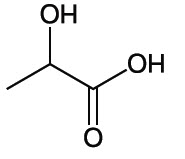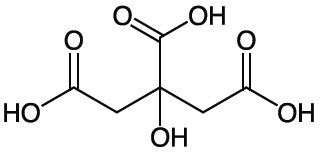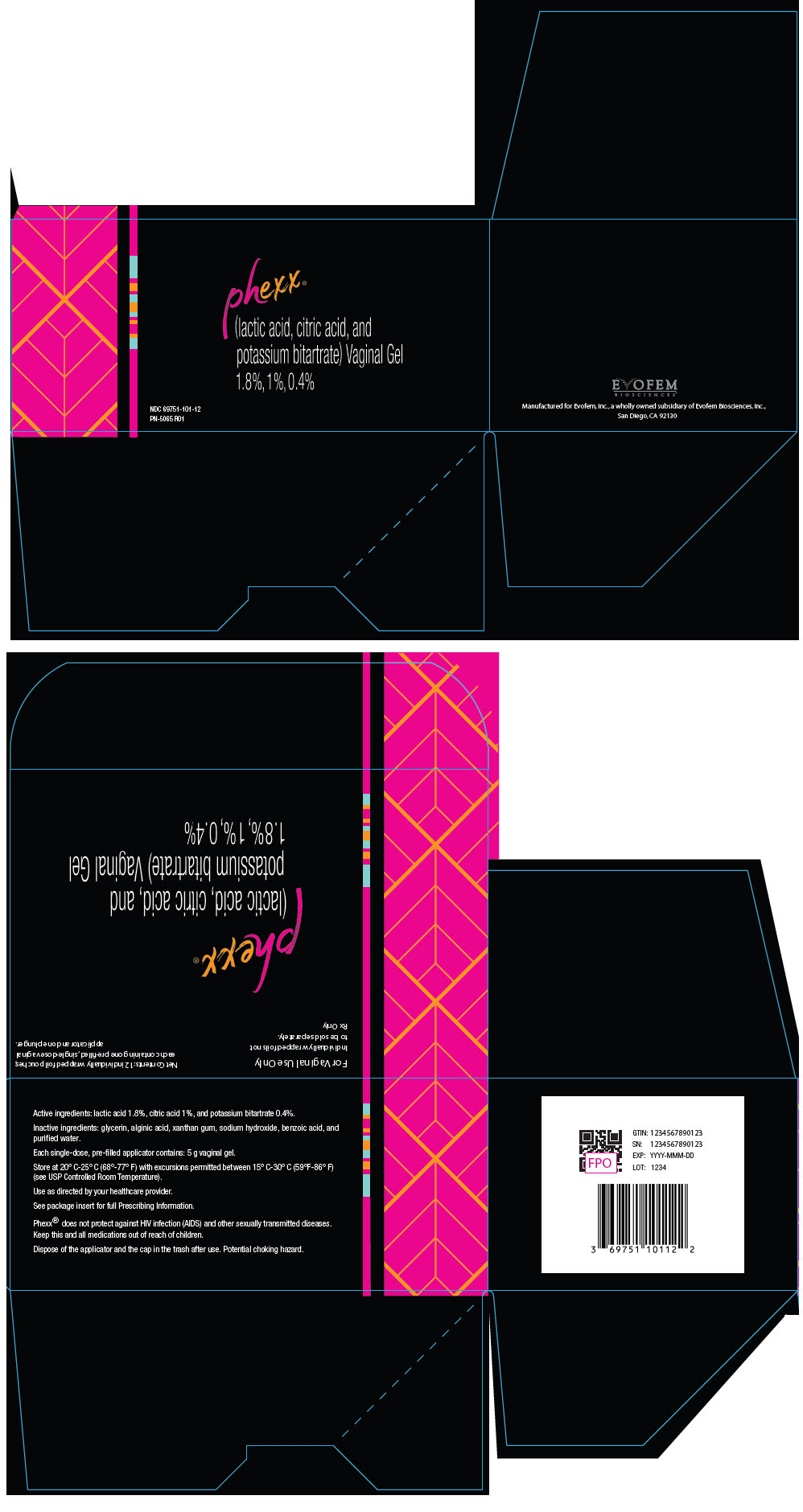^ Recommended Dosage
Administer one pre-filled applicator of PHEXX (5 grams) vaginally immediately before or up to one hour before each act of vaginal intercourse. If more than one act of vaginal intercourse occurs within one hour, an additional dose must be applied. Five grams of PHEXX contains 90 mg of lactic acid, 50 mg of citric acid, and 20 mg of potassium bitartrate.
^ Pharmacodynamics
Pharmacodynamic studies in humans have not been performed.
^ Patient Counseling Information
Advise the patient to read the Patient Information and FDA-approved patient labeling (Instructions for Use). Advise the patient:
^ Description
PHEXX (lactic acid, citric acid, and potassium bitartrate) is a vaginal gel.
PHEXX is an off-white to tan in color gel of uniform consistency, containing three active ingredients: lactic acid, citric acid, and potassium bitartrate.
The structural formula for lactic acid is:
Lactic acid is designated chemically as 2-hydroxypropanoic acid with an empirical formula of C3H6O3 and a molecular weight of 90.08 g/mol.
The structural formula for citric acid is:
Citric acid is designated chemically as 2-hydroxypropane-1,2,3-tricarboxylic acid with an empirical formula of C6H8O7 and a molecular weight of 192.124 g/mol.
The structural formula for potassium bitartrate is:
Potassium bitartrate is designated chemically as potassium; (2R, 3R)-2,3,4-trihydroxy-4-oxobutanoate with an empirical formula of KC4H5O6 and a molecular weight of 188.177 g/mol.
Each 5 gram dose is provided in a pre-filled single-dose applicator containing lactic acid USP (1.8% w/w), citric acid USP (1% w/w), and potassium bitartrate USP (0.4% w/w). Inactive ingredients present in the gel are: glycerin, alginic acid, xanthan gum, sodium hydroxide, benzoic acid, and purified water.



^ Cystitis And Pyelonephritis
Among 2804 subjects who received PHEXX in Studies 1 and 2, 0.36% (n=10) reported adverse reactions of cystitis, pyelonephritis, or other upper urinary tract infection (UTI). Of these, one case of pyelonephritis was considered serious and required hospitalization. Avoid use of PHEXX in females of reproductive potential with a history of recurrent urinary tract infection or urinary tract abnormalities.
^ Timing Of Phexx Use
May use PHEXX during any part of the menstrual cycle. May use PHEXX as soon as it is safe to resume vaginal intercourse after childbirth, abortion, or miscarriage.
^ Clinical Trials Experience
Because clinical trials are conducted under widely varying conditions, adverse reaction rates observed in the clinical trials of a drug cannot be directly compared to rates in the clinical trials of another drug and may not reflect the rates observed in practice.
The safety of PHEXX (pre-filled applicator with 5-gram dose) has been evaluated in two clinical trials (Study 1 and Study 2) in 2804 subjects (over 19,000 cycles of exposure). The racial/ethnic distribution was 66% White, 27% Black or African American, 2% Asian, 1% American Indian or Alaska Native, 0.3% Native Hawaiian or Pacific Islander, and 5% other; 32% of the study population was Hispanic. Study 1 included a one-year extension phase where 342 U.S. subjects were exposed to PHEXX for 13 cycles.
^ Clinical Studies
The efficacy of PHEXX for the prevention of pregnancy was evaluated in a multi-center, open-label, single-arm clinical trial in the United States (AMP002; NCT03243305). The study enrolled females of reproductive potential 18 to 35 years of age with regular menstrual cycles (21 to 35 days). The median age was 27.8 years. The racial distribution was 70.6% White, 23.7% Black or African American, 2.5% Asian, 0.4% American Indian or Alaska Native, 0.2% Native Hawaiian or Pacific Islander, and 2.7% other. Subjects agreed to engage in at least 3 acts of heterosexual, vaginal intercourse per cycle. Subjects self-administered a 5 gram dose of PHEXX intravaginally up to one hour before each episode of intercourse for up to 7 cycles.
The primary efficacy endpoint was the 7-cycle typical use cumulative pregnancy rate as derived by Kaplan-Meier life-table analysis. A total of 101 on-treatment pregnancies occurred in 1183 subjects contributing 4769 evaluable natural cycles. The 7-cycle cumulative pregnancy rate was 13.7% (95% CI: 10.0%, 17.5%), excluding cycles with back-up contraception, cycles <21 days or >35 days in length and cycles in which no intercourse was reported. The estimated Pearl Index, calculated based on data from the 7-cycle study, was 27.5 (95% CI: 22.4%, 33.5%).
^Principal Display Panel - Applicator Box
phexx®
(lactic acid, citric acid, andpotassium bitartrate) Vaginal Gel1.8%, 1%, 0.4%
NDC 69751-101-12PN-5065 R01

^6 Adverse Reactions
The following clinically significant adverse reactions are described elsewhere in the labeling:
^Patient Information
PHEXX® (FEX)(lactic acid, citric acid, and potassium bitartrate) vaginal gel
For Vaginal Use Only
What is PHEXX?
How well does PHEXX work?
Your chance of getting pregnant depends on how well you follow the directions for using PHEXX. The better you follow the directions, the less chance you have of getting pregnant. It is very important that you follow the directions carefully each time you have vaginal sex.
PHEXX does not protect against HIV infection or other sexually transmitted infections (STIs).
Before using PHEXX, tell your healthcare provider about all of your medical conditions, including if you:
Tell your healthcare provider about all the medicines you take, including prescription and over-the-counter medicines, vitamins, and herbal supplements.
Know the medicines you take. Keep a list of them to show your healthcare provider and pharmacist when you get a new medicine.
How should I use PHEXX?
What are the possible side effects of PHEXX?
PHEXX may cause serious side effects, including:
The most common side effects of PHEXX include:
These are not all the possible side effects of PHEXX.
Call your healthcare provider for medical advice about side effects. You may report side effects to FDA at 1-800-FDA-1088.
How should I store PHEXX?
Keep PHEXX and all medicines out of the reach of children.
General information about the safe and effective use of PHEXX.
Medicines are sometimes used for purposes other than those listed in a Patient Information leaflet. Do not use PHEXX for a condition for which it was not prescribed. Do not give PHEXX to other people, even if they have the same symptoms that you have. It may harm them.
You can ask your healthcare provider or pharmacist for information about PHEXX that is written for health professionals.
What are the ingredients in PHEXX?
Active ingredients: lactic acid, citric acid, and potassium bitartrate
Inactive ingredients: glycerin, alginic acid, xanthan gum, sodium hydroxide, benzoic acid, and purified water
For more information, go to www.phexx.com or call 1-833-EVFMBIO.
Manufactured for Evofem, Inc., a wholly owned subsidiary of Evofem Biosciences, Inc.
Unless otherwise indicated, all trademarks used herein are the property of Evofem Biosciences, Inc.
This Patient Information has been approved by the U.S. Food and Drug Administration.
© 2025 Evofem, Inc.All rights reserved.
Issued: April 2025PN-5067 R01
^3 Dosage Forms And Strengths
Vaginal gel: 18 mg of lactic acid, 10 mg of citric acid, and 4 mg of potassium bitartrate in each gram (1.8%, 1%, and 0.4%, respectively) of off-white to tan color gel supplied in a pre-filled single-dose (5 grams) vaginal applicator
^ Pharmacokinetics
Pharmacokinetic studies in humans have not been performed. Systemic exposures of lactic acid, citric acid, and potassium bitartrate following vaginal administration of PHEXX are not expected to lead to safety concerns.
In vitro studies with commonly used vaginal preparations (miconazole, metronidazole, tioconazole, and a product for maintaining normal vaginal pH) showed no significant effect on the pH or buffering capacity of PHEXX.
^ Pediatric Use
The safety and effectiveness of PHEXX have been established in females of reproductive potential. Efficacy is expected to be the same for post-menarchal females under the age of 17 as for users 17 years and older. The use of PHEXX before menarche is not indicated.
^ Use Of Phexx With Other Contraceptive Methods
PHEXX may be used concomitantly with hormonal contraceptives; latex, polyurethane, and polyisoprene condoms; and vaginal diaphragms. Avoid PHEXX use with vaginal rings.
^1 Indications And Usage
PHEXX is indicated for the prevention of pregnancy in females of reproductive potential for use as an on-demand method of contraception.
^ Use Of Phexx With Other Vaginal Products
PHEXX may be used concomitantly with other products for vaginal infections including miconazole, metronidazole, and tioconazole.
^ Mechanism Of Action
In in vitro studies, PHEXX produced a normal vaginal pH range (pH 3.5 – 4.5) in the presence of semen. In clinical studies, post-coital testing demonstrated pH <5 in the majority of subjects, and sperm motility reduction.
^ How Supplied/storage And Handling
PHEXX (lactic acid, citric acid, and potassium bitartrate) vaginal gel is an off-white to tan color gel of uniform consistency containing lactic acid (1.8%), citric acid (1%), and potassium bitartrate (0.4%), supplied as individually wrapped 5 gram pre-filled single-dose vaginal applicators in sealed foil pouches along with a plunger, and are available as follows:
^Instructions For Use
PHEXX® (FEX)(lactic acid, citric acid, and potassium bitartrate) vaginal gel
For Vaginal Use Only
These Instructions for Use contain information on how to use PHEXX vaginal gel.
Make sure that you read, understand, and follow the Instructions for Use before using PHEXX and each time you get a refill. There may be new information.
Contents:
Important Information You Need to Know Before Using PHEXX
Prepare to Use PHEXX
Keep the pre-filled applicator and plunger rod in the foil pouch until you are ready to use PHEXX.
Step 1: Wash Your Hands
Step 2: Remove the Pre-filled Applicator and Plunger Rod from the Foil Pouch
Important: Do not remove the pink cap until instructed in Step 4.
Insert PHEXX Gel
Step 3: Insert the Plunger Rod
Step 4: Remove the Pink Cap
Step 5: Insert the PHEXX Pre-filled Applicator into the Vagina
Step 6: Insert PHEXX Gel
Step 7: Remove the Used PHEXX Pre-filled Applicator
Disposing of PHEXX
Step 8: Throw Away (Dispose of) the Used PHEXX Pre-filled Applicator
Storing PHEXX
Keep PHEXX and all medicines out of the reach of children.
These Instructions for Use have been approved by the U.S. Food and Drug Administration.
For more information, including full prescribing information and information on patient safety, go to www.phexx.com or call 1-833-EVFMBIO.
Manufactured for Evofem, Inc., a wholly owned subsidiary of Evofem Biosciences, Inc.
© 2025 Evofem, Inc. All rights reserved.
Issued: April 2025